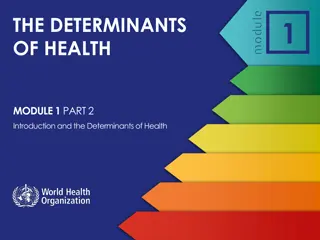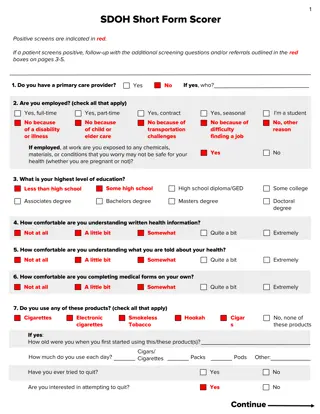Integrating Social Determinants of Health in Athletic Training Education
Explore the significance of incorporating social determinants of health (SDH) into athletic training education to enhance students' ability in identifying social factors at the point-of-care. The objectives include engaging students with SDH and implementing innovative teaching techniques. Learn about SDH, core competencies, and educational goals in this comprehensive approach. Discover how teaching SDH through video-based curriculums and service-learning can empower students to make positive changes in healthcare.
Download Presentation

Please find below an Image/Link to download the presentation.
The content on the website is provided AS IS for your information and personal use only. It may not be sold, licensed, or shared on other websites without obtaining consent from the author.If you encounter any issues during the download, it is possible that the publisher has removed the file from their server.
You are allowed to download the files provided on this website for personal or commercial use, subject to the condition that they are used lawfully. All files are the property of their respective owners.
The content on the website is provided AS IS for your information and personal use only. It may not be sold, licensed, or shared on other websites without obtaining consent from the author.
E N D
Presentation Transcript
Incorporating Social Determinants of Health into Athletic Training Education Kelsey J. Picha, PhD, AT Rhianna Freiburger, MS, ATC; Cailee E. Welch Bacon, PhD, ATC Alison R. Snyder Valier, PhD, ATC, FNATA
Objectives Appreciate the importance of engaging athletic training students with social determinants of health to improve their ability to identify social factors at the point-of-care Implement an innovative teaching technique to engage athletic training students with social determinants of health at the point-of-care
What are Social Determinants of Health (SDH)? The conditions in which people are born, grow, live, work, and age They are complex conditions that shape the overall health of an individual on a continuous basis (WHO, 2016)
(Communities in Action: Pathways to Health Equity, 2017) (WHO, 2016; NASEM, 2017; Picha, 2021)
Core Competencies Patient-Centered Care Curricular Content Standard 57 Identify health care delivery strategies that account for health literacy and a variety of social determinants of health
Teaching Social Determinants of Health Video-based curriculum for postgraduate pediatric trainees Increased screenings by trainees Service-learning/ community-based learning Informational videos & simulated patient experiences Student attitudes towards those in poverty improved Students reported feeling empowered to make change (Decker, 2017; Sabato, 2018; Sharma, 2018)
Goals of Educational Technique 1. Introduce the concept of SDH 2. Discuss and explore examples of SDH in general and athletic health care 3. Use an educational activity designed to promote observation, consideration, and reflection of SDH in clinical practice
3-Part Educational Technique (Freiburger, 2021)
Card Studies Field-tested method for gathering data in the location where patients receive care by those who provide care Disease incidence/prevalence Practice patterns Clinical behaviors Use short questionnaires clinicians complete on patients with specific conditions (Green, 1988; Westfall et al., 2011)
Who Completes the Card? Clinicians At time of visit/immediately following patient encounter Patients Immediately or return it later/by mail (Westfall et al., 2011)
3-Part Educational Technique (Freiburger, 2021)
Part 1: Informational Session Pre-activity survey How familiar are you with the concept of SDH? How comfortable are you with identifying SDH at the point of care? To what extent do you feel SDH contribute to patients health? How often do you refer patients to other resources to address SDH? My setting has adequate resources available to address SDH.
Part 1: Informational Session 1-hour presentation on SDH Concept, impact, examples 30 minutes Q & A Pair and share Instructions on card activity
3-Part Educational Technique (Freiburger, 2021)
Part 2: Observational Activity Card study framework 1 month long collection No patient demographics collected Designed to take 30 seconds or less to complete card Only after meaningful patient encounters
Meaningful Patient Encounters Prevention, evaluation, treatment, rehabilitation Yes After interacting in an evaluation or rehabilitation No - After interacting to give a bag of ice (Van Lunen et al.)
Social Factors Observed Social Factors Negative impact on the patient s health? Action Taken Access to social media/emerging technologies Behavioral health issues Cultural beliefs/values Educational limitations Family care demands Individual/family life circumstances Poor social support Language barrier Lack of health literacy Poverty/near poverty Insufficient/lack of health insurance Food insecurity Homeless/poor or unstable living conditions Transportation issues Migrant/immigration status Neighborhood safety Substance use/abuse Job/academic stressors Other: ___________________________________ I am unsure if this patient is affected by any of the listed social factors I did not observe any of the listed social factors
3-Part Educational Technique (Freiburger, 2021)
Part 3: Reflection Session One 90-minute session Discussed results of collected cards Used guiding questions to facilitate discussion Post-activity survey Student familiarity and comfort with SDH improved!
Card Activity Results Negative impact on the patient s health? (n) 12 12 11 7 2 13 9 5 15 7 6 3 0 4 2 0 3 13 2 Social Factors Observed Social Factors (n) Access to social media/emerging technologies Behavioral health issues Cultural beliefs/values Educational limitations Family care demands Individual/family life circumstances Poor social support Language barrier Lack of health literacy Poverty/near poverty Insufficient/lack of health insurance Food insecurity Homeless/poor or unstable living conditions Transportation issues Migrant/immigration status Neighborhood safety Substance use/abuse Job/academic stressors Other 104 25 33 14 19 32 17 13 33 11 11 6 4 33 3 6 7 30 3 Total 401 126
Guiding Questions 1. What are your general thoughts and feelings about the social factors you observed? Describe your experiences (eg, successes and challenges) you had observing and identifying potential social factors. How did you perceive a social factor was having a negative impact on a patient s health? a) Was determining if a social factor had a negative impact on a patient s health difficult? Why or why not? Did you take any action once you identified a negative social factor? a) If so, what did you do? If not, why not? What resources do you have access to in your clinical setting that could be used to reduce patient s negative social factors? a) What resources can you think of that would help you improve care when you observe a patient experiencing the negative impact of a social factor? Were there things that surprised you about your observations? Have your perceptions about the social determinants of health changed with completion of this activity? a) If so, how? If not, why not? 2. 3. 4. 5. 6. 7.
Post-Activity Survey How comfortable are you identifying SDH at the point of care? How familiar are you with the SDH concept? 20 15 15 10 10 5 5 0 0 Not at all comfortable Minimally comfortable Moderately comfortable Extremely comfortable Not at all familiar Minimally familiar Moderately familiar Extremely familiar Pre Post Pre Post
Considerations for Implementation Post-professional 22 students total 1st and 2nd year Settings: secondary and collegiate Incorporated into grand rounds programing
Considerations for Preceptors Are they able to aide in student learning and observations of SDH? Do they need additional education on SDH? Can they actively engage in an observation activity with students to further promote conversation and learning?
Athletic Trainers Perceptions 1694 ATs surveyed to determine their perceptions of SDH Perceptions of Familiarity Comfort Knowledge (perceived & actual) (Picha et al. in preparation)
Athletic Trainers' Familiarity with SDH Athletic Trainers' Knowledge about SDH 45% 42% 800 800 37% 35% 700 700 600 600 # of respondents # of respondents 500 500 18% 400 400 16% 300 300 200 3% 200 4% 100 100 0 0 Athletic Trainers' Comfort with SDH 800 41% 35% 700 600 # of respondents 500 20% 400 300 200 4% 100 0 Extremely comfortable Moderately comfortable Minimally comfortable Not (Picha et al. in preparation) comfortable at all
Clinical Advantages Active Improved familiarity Reflection Improved comfort Improved observations
Take Home Messages There is a need for inclusion of SDH in didactic and clinical education A card study activity is a viable option for athletic training educators Student perceptions of their familiarity and comfort in identifying SDH increased
Thank you! Kelsey Picha- kpicha@atsu.edu























